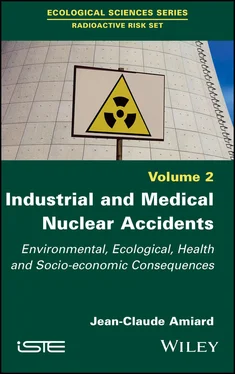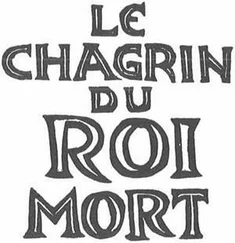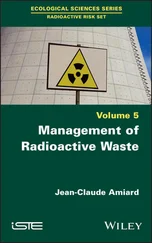1
Classification of Civil, Industrial and Medical Nuclear Accidents
In the first volume of this series [AMI 19], we reviewed the definitions of nuclear incidents and accidents, and provided the American classification for military accidents.
The generally accepted definition of an accident is “a fortuitous event that has more or less harmful effects on people or things”. The term accident frequently implies apparent medical damage, morbidity or even mortality [NÉN 01, NÉN 06, NÉN 07]. When the accident is very serious, the terms catastrophe (the event that causes serious disruption and death) or calamity (a public misfortune where misfortune affects a region, a group of individuals) are used. On the contrary, the term incident refers to “an occurrence, a secondary event, generally unfortunate, that occurs during an action and can disrupt its normal course”.
Nuclear accidents in the civil, industrial and medical fields occur involuntarily following either a major natural event (earthquake, tsunami, etc.) or human error with serious repercussions, or could result from an act of terrorism.
The most serious nuclear accidents cause considerable damage to the environment, flora, fauna and humanity. In addition, their socio-economic impacts can be immense.
1.1. Nuclear accident or radiological accident?
To answer this question, it is necessary to define some essential terms in nuclear physics. An atom, an elementary unit, is made up of a nucleus and electrons that gravitate around it. Each nucleus consists of protons (Z) and neutrons (N), the sum constituting the nucleons (A=Z+N). For the same element, the composition of the nucleus may differ in terms of the number of protons and neutrons, each composition constituting an isotope. Some elements can have many isotopes.
The simplest of the elements, hydrogen, consists of a very abundant isotope with a single proton and a single electron. There are two other isotopes: deuterium (nucleus comprising a proton and a neutron) and tritium (nucleus consisting of a proton and two neutrons). The great difference in the constitution of the nucleus explains the exceptional attribution of a particular name. Hydrogen is the most abundant isotope (99.98%), the other two isotopes being very much in the minority. A contrasting example is cesium, where 40 isotopes coexist with a number of nucleons ranging from 112 to 151.
For a given element, some isotopes are unstable and therefore radioactive. To regain their atomic stability, they must get rid of an electron, a helium nucleus or a photon. These unstable isotopes are called radionuclides.
In hydrogen elements, only the tritium isotope is unstable and radioactive. It recovers its stability by losing an electron and thus transforming into helium. In the case of cesium, only one isotope is stable, cesium 133 ( 133Cs) containing 78 neutrons. All other isotopes are radionuclides, two of which are important: cesium 134 ( 134Cs) and cesium 137 ( 137Cs) because they are fission products of uranium 235 ( 235U).
The return to stability is not always a one-step process. There are often several descendants. For example, there are three main natural families whose leaders are uranium 238 with 14 descendants, uranium 235 and thorium 232 with 11 descendants each.
The toxicity of radionuclides is twofold, chemical toxicity resulting from their elementary characteristics and radiotoxicity from their emission of ionizing radiation. With the exception of uranium, which has a high chemical toxicity, radiotoxicity is considered, for other radionuclides, to be the most dangerous.
As a chemical element, the radionuclide will participate in the usual chemical reactions, disperse into various compartments of the environment and enter living organisms through various pathways (including food). This results in radioactive contamination of the environment and living beings (external and internal contamination).
By definition, any event affecting the entire atom will qualify as atomic. When the event takes place at the nucleus level, the event will be nuclear. The distinction between atomic and nuclear events was abandoned in the 1950s because the term atomic had too negative a connotation and only the term nuclear remained for civil activities. An accident involving releases of radionuclides to the environment will therefore be a nuclear accident. When only ionizing radiation reaches the living being, the event qualifies as radiological. This is the case when radioactive contamination remains external and confined. An accident with an intact radioactive source or linear accelerator will therefore be a radiological accident.
In the case of a nuclear accident, the International Atomic Energy Agency’s (IAEA) International Nuclear Event Scale (INES) will be used as a calibration to estimate the severity of the accident. In the case of a radiological accident, another scale such as the ASN-SFRO or radiological scale should be used instead.
1.2. Classification of nuclear accidents. Incident or accident?
Following the accidents at Three Mile Island in 1979 and Chernobyl in 1986, the IAEA decided to create an INES. This scale was implemented worldwide in 1991. It has eight severity levels rated from 0 to 7. For quantifiable events of a comparable nature, the scale is logarithmic, the change from one level to another corresponding to a factor of 10.
Since 1991, the INES has enabled the establishment of a common language for the assessment of an incident or accident in the nuclear sector. The OECD, then the IAEA, drew heavily on a nuclear event severity scale set up by France in 1987 to design the INES. This common international reference makes it easier to understand public opinion. Information on an event is communicated via the IAEA to all countries that have adopted the INES [LEC 04].
The INES is based on several criteria that are taken into account to define the nuclear event’s severity level. The reported events are analyzed according to their consequences at three levels: (1) wider impacts on people or property (worker and/or public health); (2) on-site impacts; and (3) defense-in-depth impacts (presence of several containment barriers). This approach is detailed in Table 1.1.
Table 1.1. The severity levels of a nuclear event. The INES
| Type |
INES |
Wider impact |
On-site impact |
Damage to defense-in-depth |
| Major accident |
7 |
Major release: widespread effects on health and the environment |
|
|
| Serious accident |
6 |
Significant release likely to require full implementation of planned countermeasures |
|
|
| Accident (resulting in wider consequences) |
5 |
Limited release likely to require partial application of planned countermeasures |
Serious damage to the reactor or radiological barriers |
|
| Accident (not resulting in a significantly wider risk) |
4 |
Minor release: public exposure within statutory limits |
Significant damage to the reactor or radiological barriers, or lethal exposure of a worker |
Loss of defenses and contamination |
| Serious incident |
3 |
Very small release: public exposure represents a fraction of the statutory limits |
Serious contamination or acute effects on a worker’s health |
Accident narrowly avoided. Loss of defense lines |
| Incident |
2 |
No consequences |
Significant contamination or overexposure of a worker |
Incident with significant failure of safety provisions |
| Anomaly |
1 |
No consequences |
No consequences |
Anomaly not included in the authorized modus operandi |
| Deviation |
0 |
No consequences |
No consequences |
Insignificant anomaly from a safety point of view |
The transition from incident (levels 1–3) to accident (levels 4–7) is characterized by environmental contamination that can damage public health.
Читать дальше












